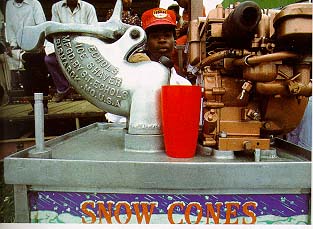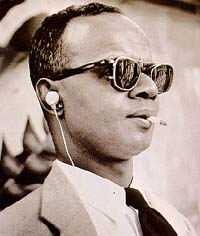
Ice Cream vendor. The words "Snow Cones" here show the British
influence. 《國家與人民》 p. 204
Economical problems: In the early 1970's, black-power supporters
protested against widespread unemployment and what they considered social
and economic inequality in Trinidad and Tobago. Violent demonstrations
broke out, and the government twice declared a state of emergency.
Racial tensions eased in the mid-1970's, but unemployment continued to
be a major problem in the country.
|
-
history: Discovered by Columbus in 1498, and then settled by the
Spaniards. British rule was established in 1802. Joined the
West Indies Federation in 1958, but left to become independent in 1962.
 Independence:
Trinidad--1956, it was lead by Eric Williams (1956-1981) in 1950s.
He became Prime Minister in 1955. His People's National Movement
(PNM) was in power for thirty years (1966-1986). Independence:
Trinidad--1956, it was lead by Eric Williams (1956-1981) in 1950s.
He became Prime Minister in 1955. His People's National Movement
(PNM) was in power for thirty years (1966-1986).
-
In 1980, the
national government allowed a local governing council to be established
on Tobago island.
|
population & language: 43% African, 36% Indian, some whites and Chinese.
Virtually all speak English. Small percentages also speak Hindi, French patois, and several
other dialects.
cultures: Trinidad has two major folk traditions: Creole and East Indian. Creole is a mixture of African
elements with Spanish, French, and English colonial culture.
Trinidad's East Indian culture came to the island with indentured servants brought to fill a labor shortage created by the emancipation of the African slaves in 1833. Most remained on the land, and they still dominate the agricultural sector, but many have become prominent in business and the professions. East Indians have retained much of their own way of life, including Hindu and Muslim religious festivals and practices.
(source)
Authors: Sam Selvon (India-Trinidad-U.K.-Canada); Neil Bissoondath
(India-Trinidad-Canada)
|